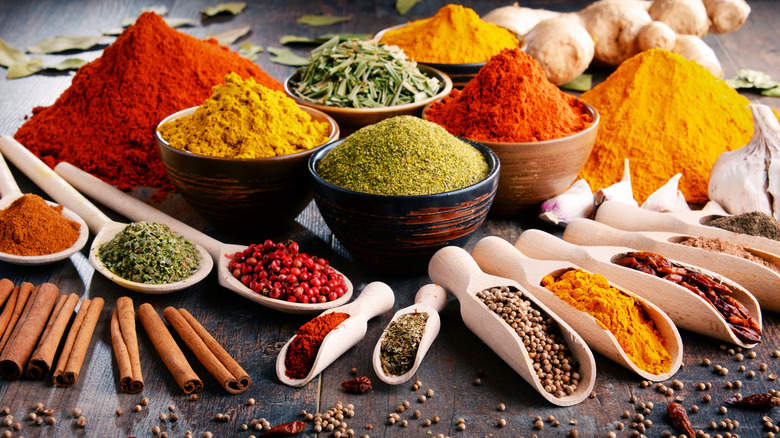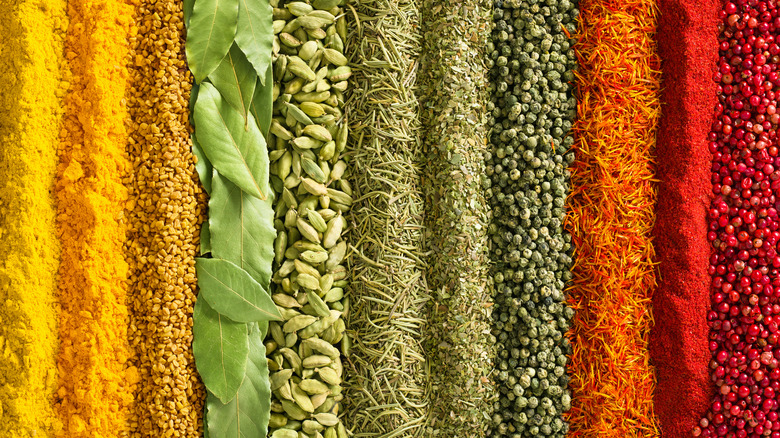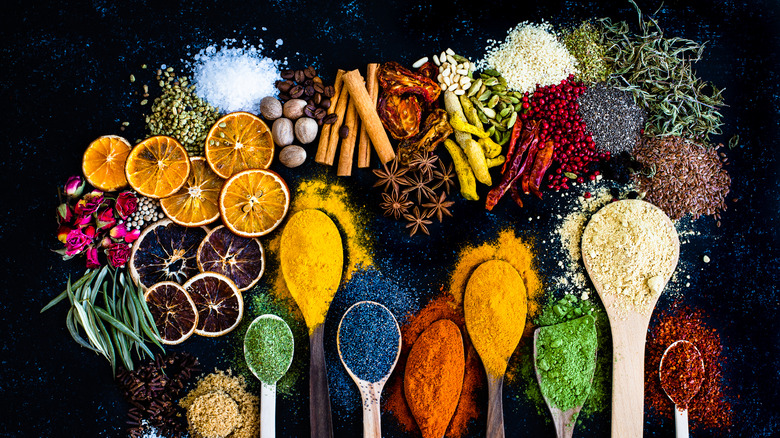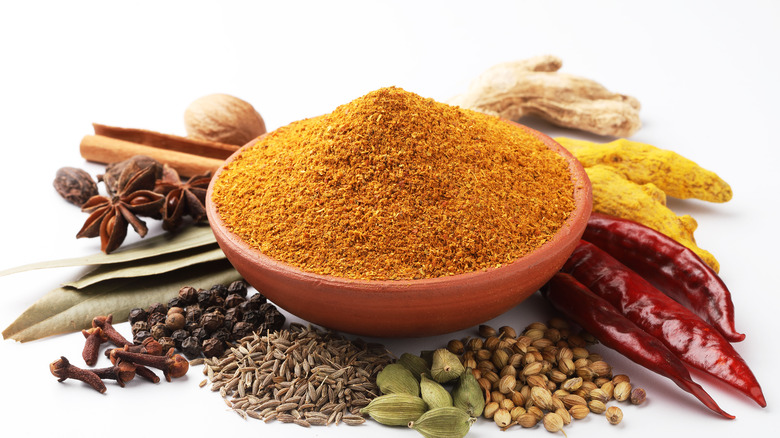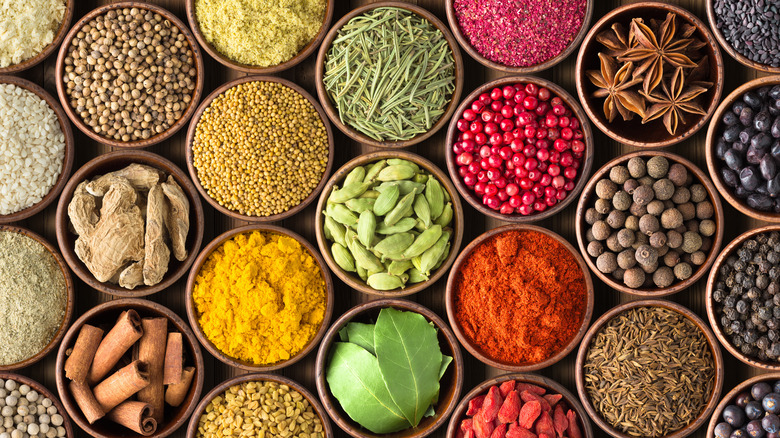What Is Curry Powder And What Does It Taste Like?
Curry can be defined as dish, a leaf, or a powder or spice blend, but be careful not to automatically think of the jarred, yellowed spice blends you may often see in the supermarket. Curry is wide-ranging and versatile, a term that can mean different things in different places, and has inherent distinctions from country to country.
First and foremost, "curry powder" is a generic, catchall term. MasterClass deems curry powder "a product of colonization and globalization," which certainly sums up precisely why defining curry powder is so difficult.
In most jarred varieties, turmeric is the primary ingredient. The powder was initially created by British colonizers in order to approximate the rich flavors of the Indian subcontinent. Throughout these countries, spice mixes vary from family to family, but there are some exceptions, such as garam masala or Madras curry powder. Furthermore, these blends are often ground fresh, whereas generic curry powders may sit in bottles on supermarket shelves for months. Traditionally, these cherished spice blends were made with a mortar and pestle and resulted in an intensely fragrant experience. Nowadays, spice or coffee grinders work best when it comes to crushing your own spices at home.
What is the history of curry powder?
Spices Inc. notes that a third century Greek treatise refers to a dish "dressed in the Indian fashion," but acknowledge that "curry" itself wasn't named until the colonization of India began around the 1500s. It is said that the Portuguese appropriated a Tamil word, such as "caril" or "kari," and repurposed it as "curry." While traditional Indian curries such as vindaloo or butter chicken may be referred to as "curries," they would never be called that in India; they would only be referred to by their name. As Spices Inc. states, "curries ... existed as a food entity before the British empire and Indian diaspora carried it around the world."
Not spicy, per se, but warming, piquant, and earthy, "curry powders" lend a deep, rich flavor and often a golden hue, courtesy of turmeric. My Recipes notes that while many associate curry powder with India, variations are also widely used in Thailand, Indonesia, Pakistan, and many other cultures and cuisines. Technically attributed to English colonists during the Indian spice trade, the British, unaccustomed to the flavorful spice blends, used the term "curry" to describe any spice blend that could mimic the intense flavorings of the dishes eaten by the locals. As Epicurious notes, this was also exponentially challenging seeing as how the flavors and spices used in Indian cuisines change markedly from region to region, as well as country to country. Since then, many offshoots, varieties, and imitations have been created, bottled, and sold.
What is curry powder made of?
Supposedly, the first printed mention of curry powder is in a British advertisement in the 1780s, and the first bottled curry powder was sold soon after in the UK, according to Spiceography. Nowadays, McCormick's curry powder contains 11 ingredients: coriander, fenugreek, turmeric, cumin, black pepper, bay leaves, celery seed, nutmeg, clove, onion, ginger, and red pepper. Most curry powders do not contain any salt. A common Madras curry powder recipe might consist of coriander, cumin, fenugreek, cassia bark, cardamom, black pepper, chilies, curry leaves, and turmeric, according to Food52.
The majority of the ingredients would be toasted in order to bring out their flavors, oils, and aromas prior to being crushed or ground. Garam Masala, on the other hand, often has a bit more sweetness and may be more assertive. It may contain cinnamon, cardamom, nutmeg, cloves, coriander, and-or cumin, according to The Spruce Eats. The slight variations are just one of the many wonderful aspects that make curry powders so distinctive.
How do you cook with curry powder? Is it healthy?
Curry powders are versatile, wide-ranging, and downright delicious. Some wonderful uses for curry powders (besides in curries, of course) are with roasted veggies, sprinkled on popcorn, blended into hummus, or stirred into vinaigrettes. Many cooks include curry powders in samosas, grain or rice bowls, with grilled proteins, in soups, and in flavorful butters. It is great in chicken salad, egg dishes, and even desserts, such as sprinkled over ripe mango. Its bold, robust flavor helps to accentuate any dish it's added to, and its golden hue adds a picturesque note. It is helpful to "bloom" curry powders in heated oil or with aromatics, which allows the flavor to further permeate the dish.
Healthline also notes curry powder's anti-inflammatory properties, promotion of heart health, improvement of brain health, lowering of blood sugar, and boosting of digestive health. It also may have anti-cancer properties, promote satiation, and contain many antioxidants. The Spruce Eats also notes that it contains vitamin B6, manganese, iron, vitamins K and E, and fiber. Furthermore, it might be helpful in reducing the risk of diabetes, lower cholesterol, prevent gallstones, eliminate lead and toxic metals, and help reduce stress. All of the wonderful spices and herbs help to make any dish laced with curry powder immensely healthful.
What are some of the other varieties of curry powder?
Curry powders can be purchased almost anywhere, but specialty markets and various website are excellent sources for curry powder shopping. Some spice shops also allow sampling. Curry powders can often last years, but will of course lose potency as time goes by.
"Curry powder" is a wide-ranging phrase and can encapsulate myriad cuisines, cultures, and countries. Other popular curry varieties are Vindaloo curry powder, Maharajah, and Sweet, and each has a different spice level. Countries within Africa and the Caribbean also have varieties of curry powder, such as fiery Jamaican curry powder, as well as Moroccan curry powders such as Ras El Hanout, which means "top of the shop," often a mix of the most popular and/or best-selling spices within that market (via Spices Inc.). Other popular curry powder blends are chaat masala, tandoori masala, Japanese curry powder, and many, any more. (via Kitchen Stories). Vadouvan has a slight twist, with shallot, garlic, and mustard, according to Epicurious. Other varieties are Thai, Trinidian, and Sri Lankan curry powders, all which have their own distinctive properties, flavors, aromas ,and ingredients. All Recipes notes that Thai curry powder, for example, has lemongrass and lime leaves, while Caribbean curry powders often include anise and allspice.
The nuances present from curry powder to curry powder help to further clarify that the term "curry powder" is far too inexact to properly represent these widely (and deliciously) varying flavor profiles.
